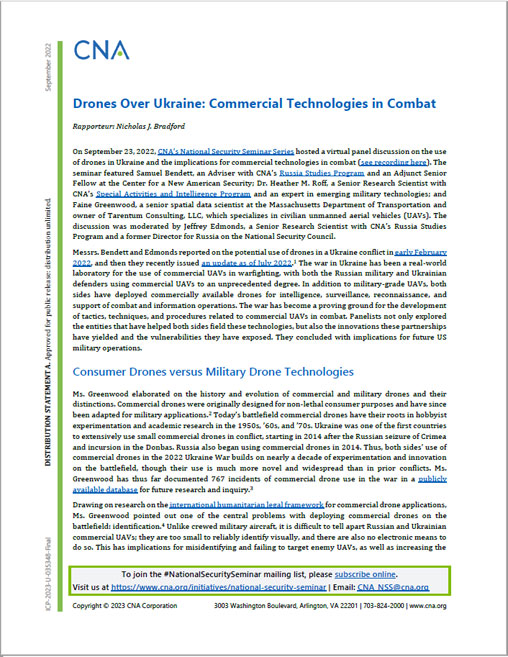On September 23, 2022, CNA’s National Security Seminar Series hosted a virtual panel discussion on the use of drones in Ukraine and the implications for commercial technologies in combat (see recording here). The seminar featured Samuel Bendett, an Adviser with CNA’s Russia Studies Program and an Adjunct Senior Fellow at the Center for a New American Security; Dr. Heather M. Roff, a Senior Research Scientist with CNA’s Special Activities and Intelligence Program and an expert in emerging military technologies; and Faine Greenwood, a senior spatial data scientist at the Massachusetts Department of Transportation and owner of Tarentum Consulting, LLC, which specializes in civilian unmanned aerial vehicles (UAVs). The discussion was moderated by Jeffrey Edmonds, a Senior Research Scientist with CNA’s Russia Studies Program and a former Director for Russia on the National Security Council.
Messrs. Bendett and Edmonds reported on the potential use of drones in a Ukraine conflict in early February 2022, and then they recently issued an update as of July 2022. The war in Ukraine has been a real-world laboratory for the use of commercial UAVs in warfighting, with both the Russian military and Ukrainian defenders using commercial UAVs to an unprecedented degree. In addition to military-grade UAVs, both sides have deployed commercially available drones for intelligence, surveillance, reconnaissance, and support of combat and information operations. The war has become a proving ground for the development of tactics, techniques, and procedures related to commercial UAVs in combat. Panelists not only explored the entities that have helped both sides field these technologies, but also the innovations these partnerships have yielded and the vulnerabilities they have exposed. They concluded with implications for future US military operations.
Consumer Drones versus Military Drone Technologies
Ms. Greenwood elaborated on the history and evolution of commercial and military drones and their distinctions. Commercial drones were originally designed for non-lethal consumer purposes and have since been adapted for military applications. Today’s battlefield commercial drones have their roots in hobbyist experimentation and academic research in the 1950s, ’60s, and ’70s. Ukraine was one of the first countries to extensively use small commercial drones in conflict, starting in 2014 after the Russian seizure of Crimea and incursion in the Donbas. Russia also began using commercial drones in 2014. Thus, both sides’ use of commercial drones in the 2022 Ukraine War builds on nearly a decade of experimentation and innovation on the battlefield, though their use is much more novel and widespread than in prior conflicts. Ms. Greenwood has thus far documented 767 incidents of commercial drone use in the war in a publicly available database for future research and inquiry.
Drawing on research on the international humanitarian legal framework for commercial drone applications, Ms. Greenwood pointed out one of the central problems with deploying commercial drones on the battlefield: identification.4 Unlike crewed military aircraft, it is difficult to tell apart Russian and Ukrainian commercial UAVs; they are too small to reliably identify visually, and there are also no electronic means to do so. This has implications for misidentifying and failing to target enemy UAVs, as well as increasing the potential for fratricide and friendly fire. This is further complicated by the operation of non-combatant drones by journalists in the same airspace.
Another novel aspect of battlefield commercial drone applications in Ukraine has been the role of the private sector. The private industry’s role in producing and controlling drone software has several implications. There are inherent security risks in operating drones (both the software and the hardware) produced by a foreign country. Private companies can directly curtail market access to their products, as Chinese producer DJI has done with Russia and Ukraine, or they could even intervene directly in operations by activating geo-fencing, a capability DJI has not exercised thus far in the current conflict.
Download reportDISTRIBUTION STATEMENT A. Approved for public release: distribution unlimited.
Details
- Pages: 4
- Document Number: ICP-2023-U-035348-Final
- Publication Date: 9/30/2022
